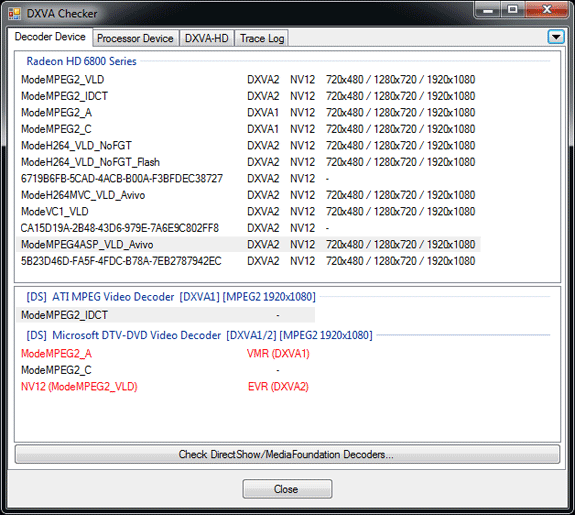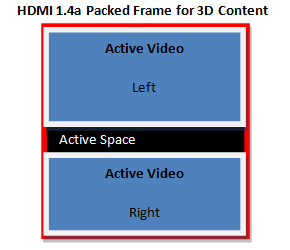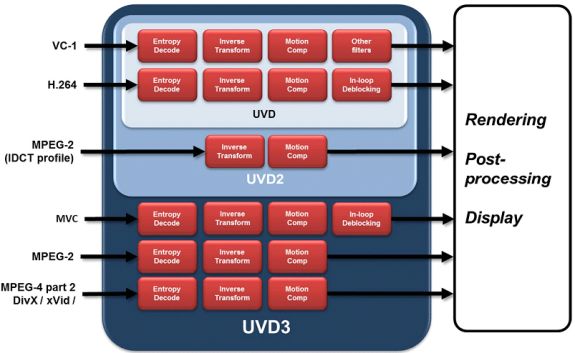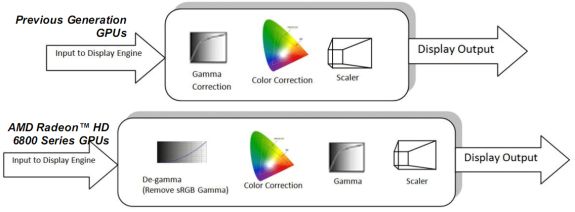AMD’s Radeon HD 6870 & 6850: Renewing Competition in the Mid-Range Market
by Ryan Smith on October 21, 2010 10:08 PM ESTSeeing the Present: HDMI 1.4a, UVD3, and Display Correction
DisplayPort wasn’t the only aspect of AMD’s display controller that got an overhaul however, AMD’s HDMI capabilities have also been brought up to modern standards. Coming from Cypress with support for HDMI 1.3, AMD now supports HDMI 1.4a on the Barts based 6800 series and presumably they will do so on the rest of the 6800 series too. With HDMI 1.4a support AMD can now support full resolution (1080p) 3D stereoscopy for movies, and 720p for games and other material that require 60Hz/eye, along with 4k x 2k resolution for monitors and TVs that have equivalent support. Unlike DP this has less to do with monitors and more to do with TVs, so the importance of this will be seen more on future AMD cards when AMD refreshes their lower-end parts that we normally use with HTPCs.
Launching alongside support for displaying full resolution 3D stereoscopic video is the hardware necessary to decode such video, in the form of the latest version of AMD’s Unified Video Decoder: UVD3. The last time UVD received a major update was with UVD2, which launched alongside the Radeon HD 4000 series and added partial MPEG-2 decoding support by moving IDCT and MoComp from shaders in to the UVD fixed function hardware.
With the Radeon 6800 series AMD is releasing UVD3, which like UVD2 before it builds on the existing UVD feature set. UVD3 is adding support for 3 more-or-less new codecs: MPEG-2, MVC, and MPEG-4 ASP (better known as DivX/XviD). Starting with MPEG-4 ASP, it’s the only new codec in supported by UVD3 that’s actually new, as previously all MPEG-4 ASP decoding was done in software when it came to AMD GPUs. With UVD3 AMD can now completely offload MPEG-4 ASP decoding to the GPU, bringing forth the usual advantages of greatly reducing the amount of work the CPU needs to do and ideally reducing power consumption in the process.
AMD adding MPEG-4 ASP support gives us an interesting chance to compare and contrast them to NVIDIA, who added similar support a year ago in the GT21x GPUs. AMD is a good bit behind NVIDIA here, but they’re making up for it by launching with much better software support for this feature than NVIDIA did; NVIDIA still does not expose their MPEG-4 ASP decoder in most situations, and overall did a poor job of advertising it. When we talked with DivX (who is AMD’s launch partner for this feature) they didn’t even know that NVIDIA had MPEG-4 ASP support. Meanwhile AMD is launching with DivX and had a beta version of the DivX codec with UVD3 support ready to test, and furthermore AMD is fully exposing their MPEG-4 ASP capabilities in their drivers as we see in this DXVA Checker screenshot.

The only downside at this time is that even with Microsoft’s greater focus on codecs for Windows 7, Windows 7 doesn’t know what to do with DXVA acceleration of MPEG-4 ASP. So while Win7 can play MPEG-4 ASP in software, you’re still going to need a 3rd party codec like the DivX codec to get hardware support for MPEG-4 ASP.
The other bit worth mentioning is that while AMD is launching support for MPEG-4 ASP decoding here on the 6800 series, much like HDMI 1.4a it’s not going to be a big deal for the 6800 series market. MPEG-4 ASP is a fairly lightweight codec, so support for it is going to be a bigger deal on low-end products, particularly AMD’s APUs if Llano and Bobcat end up using UVD3, as MPEG-4 ASP decoding in software requires a much greater share of resources on those products.
Up next is MPEG-2, which has been a codec stuck in limbo for quite some time over at AMD. MPEG-2 is even older and easier to decode than MPEG-4 ASP, and while GPUs have supported MPEG-2 decode acceleration as early as last decade, CPUs quickly became fast enough that when combined with low levels of hardware decode acceleration (inverse discrete cosine transform) was more than enough to play MPEG-2 content. Thus AMD hasn’t done much with MPEG-2 over the years other than moving IDCT/MoComp from the shaders to UVD for UVD2.
Because of the similarities between MPEG-4 ASP and MPEG-2, when AMD added support for full MPEG-4 ASP decode acceleration they were able to easily add support for full MPEG-2 decode acceleration, as they were able to reuse the MPEG-4 ASP entropy decode block for MPEG-2. As a result of including full MPEG-4 ASP decode acceleration, AMD now supports full MPEG-2 decode acceleration. Even more so than MPEG-4 ASP however, the benefits for this are going to lie with AMD’s low-end products where getting MPEG-2 off of the CPU should be a boon for battery life.

The final addition to UVD3 is support for Multiview Video Coding, which isn’t a new codec per se, but rather is an extension to H.264 for 3D stereoscopy. H.264 needed to be amended to support the packed frame formats used to store and transmit 3D stereoscopic videos, so with UVD3 AMD is adding support for MVC so that UVD can handle Blu-Ray 3D.
Finally, coupled with support for new codecs and new display outputs in AMD’s display controller is a refinement of AMD’s existing color correction capabilities in their display controller. Cypress and the rest of the 5000 series could do color correction directly on their display controllers, but they could only do so after gamma correction was applied, meaning they had to work in the non-linear gamma color space. Technically speaking this worked, but color accuracy suffered as a result. With the 6800 series’ new display controller, AMD can now perform color calibration in linear space by converting the image from gamma to linear color space for the color correction, before converting it back to gamma color space for display purposes.
As color correction is being used to correct for wide-gamut monitors the importance of this change won’t be seen right away for most users, but as wide-gamut monitors become more widespread color correction becomes increasingly important since wide-gamut monitors will misinterpret the normal sRGB colorspace that most rendering is done in.












197 Comments
View All Comments
Setsunayaki - Friday, October 22, 2010 - link
There was a graph where a 4XXX series card beat the 6XXX series card...There were many where the 5XXX series was higher...Tesellation performance is higher on the 460 GTX and SLI scales better than crossfire...What the tesselation performance graph really means is that if you were to take an 460 GTX and 6870 and turn off tesselation and play a game....the 6870 gets a higher framerate, but if you turn on Tesselation on Both cards and go full force with Tesselation and other features (considering that Nvidia has support for PhysX and most games now have some physics implementation)...the outcome shows the 6870 taking such a performance hit that as far as framerates go....a 460 actually matches it or beats it outright.
What ATI/AMD really needs to work on is Integrating more technologies on its card to actually have more options during a game. No physics processing, Just an optimization on AA and AF...and tesselation performance that doesn't come close to a 460, along with horrible linux support...I really wonder and hope that their flagship card shows something steller....
Not to argue against it, but for the deserving ATI/AMD fans who have stuck with them over the years. ^_^
Alilsneaky - Friday, October 22, 2010 - link
Prices are high for both in my country (Belgium).199 Euro for the 6850 and 279 euro (in the cheaper shops, upto 350 in others) for the 6870.
Very bland release for us, nothing to get excited about at that price point.
I also take offense to the naming scheme, why pick a name that will inevitable deceive many people into buying a sidegrade.
Pastuch - Friday, October 22, 2010 - link
There was not nearly enough discussion on DTS HD MA and TrueHD pass through in this article. Gaming is 50% of the reason to upgrade, the rest of my focus is HTPC use. Please compare the GTX 460 vs the 6870 regarding bit-streaming, video quality and hardware decoding.Thanks.
P.S. Nvidia usually does a pathetic job on anything not related to gaming.
Scootiep7 - Friday, October 22, 2010 - link
I think you guys are a little off on calling the 6870 the $200 price point King. The cheapest retail for the card right now is $239.99 for any model and then you have to add in another $5~10 for shipping. That sticks it at $245 - $250. That's no where near the $200 price point. And with most GTX 460 1GBs sitting at about $170 - $190 (w/ shipping), this card is not competing with them on price at all. Maybe in a few months if prices drop, but not now. It's more in the GTX 470 range and that is much tougher competition. I'm sorry, but the 6870 is NOT the $200 price point King. It's not even close.Lolimaster - Sunday, October 24, 2010 - link
HD6850 offers better performance tha 460 1GBHD6850 costs $175
HD6870 kill both of them, and also 470 performance/power consumption (80w less)
Scootiep7 - Sunday, October 24, 2010 - link
Ok, I'm sorry, but I have to laugh at this. Where the hell are you finding a 6850 for $175. The cheapest ANYWHERE is $199 and you still have to factor in #8ish shipping. Re-read my post and realize that the prices I quoted are accurate and you're still looking at a $30 price difference between the 6850 and the 460 1gb. Yes the performance is better, but it's not amazingly better and I don't think it justifies it. Hey, I'm all for the red team this time around. I picked up a 5770 which is an amazing bang for the buck card. I'm just saying that calling the 6870 or the 6850 the new $200 price point king is wrong. Too many variables.orthancstone - Friday, October 22, 2010 - link
I'm especially pleased to see the 4870 included in some benchmarks. As someone who owns one and who was never impressed with the performance boost/cost ratio of the 58/59xx lines, I've been wondering how the 6xxx line would compare to the two generation old stuff. I'd love to see it included in the third party 6xxx reviews.Edison5do - Friday, October 22, 2010 - link
As a owner of a HD 4850 was planning to get an HD 5770 but at this point it looks like HD 6850 looks like a better option with a few more bucks.. or wait to see if the HD 5770 will drop price a little more....Sando_UK - Friday, October 22, 2010 - link
Anandtech is one of my favourite review sites and it's a real shame to see what's happened here. I don't know the reasons why you guys needed to include the 460 OC in this review (does sound like a fine card btw, but this wasn't the place for it) - can't see any reason this wouldn't have been much better compared in a separate article. The fact Tom's hardware did a very similar thing makes the whole thing fishy...New generations/architectures don't come along very often and deserve proper comparison and coverage - I'm not an AMD or Nvidia fanboi (happy to go with whichever is best price/performance/extras at the time) but we rely on you guys to give us the facts on a level playing field. I'm sure you have in this case, but even the suggestion of impropriety damages you (extremely good) reputation, and I think it's something you should really try to avoid in the future - be it AMD or Nvidia reviews.
Otherwise, thanks for all your hard work.
Natfly - Friday, October 22, 2010 - link
It's sad to say, but this review fucking sucks. UVD and the display controller have been overhauled but you make no mention of any of the changes. Are there still only 2 RAMDAC clocks? Or can you now use passive DP converters while using both of both DVI ports?And including an OC'd card because nVidia pushed you into it? Way to take a shot to your credibility. And no mention of its clocks or price... AND no overclocking numbers for these new cards when you are specifically comparing it to an OC'd card? I mean wtf, this review is not up to previous Anandtech standards.